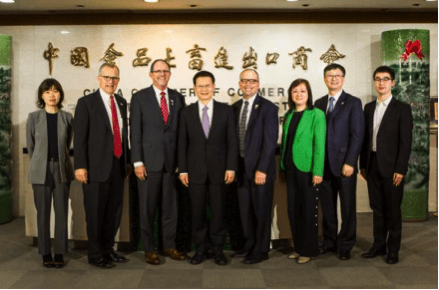
U.S. Soy Grower Leaders Visit China on Experience Today’s U.S. Soy Advantage Tour
U.S. Soy grower leaders Davie Stephens, American Soybean Association (ASA) president, and Keith Tapp, United Soybean Board (USB) chairman were part of a team that hosted meetings in China between April 2 and 4 as part of the ongoing multi-country tour to promote U.S. Soy. The meetings are part of USSEC’s efforts to consolidate and expand rapport with international customers and stakeholders.
On the morning of April 2, Mr. Stephens and Mr. Tapp, along with USSEC CEO Jim Sutter, met with Patrick Yu, president of COFCO, and officials in charge of the corporation’s oil and meat departments. Both sides expressed hope that the current trade tension could be resolved, bilateral trade could get back on track, and cooperation between COFCO and U.S. Soy could further develop in the future. They also discussed issues including the impact of African Swine Fever on China’s pork supply and feed demand, the quality of U.S. soybean, and China’s new rules governing foreign materials in imported soybeans.
At noon, the U.S. Soy delegation hosted a lunch meeting with Leicester Ross, chair of Policy Committee of the American Chamber of Commerce in China, and discussed the ongoing trade tension.
That afternoon, the U.S. Soy delegation met with Cao Derong, the new president of the China Chamber of Commerce of Foodstuffs and Native Produce (CFNA). President Cao endorsed the long-term partnership between CFNA and the U.S. Soy industry, and said CFNA, under his leadership, is willing to further build on this friendship and strengthen concrete cooperation to facilitate the two countries’ agriculture development, trade, and sustainable growth, among other things.


On April 3, the delegation flew to Shanghai to host the China – U.S. Soy Trade Seminar. Prior to the seminar, they had a one-hour closed-door meeting with Terry Branstad, U.S. Ambassador to China, Sean Stein, Consul General at the U.S. Consulate General in Shanghai, Bobby Richey, Minister-Counselor of Agricultural Affairs, among other Embassy and Consulate officials.

The China – U.S. Soy Trade Seminar was part of USSEC’s international marketing efforts to promote the U.S. Soy advantage. Branded as “Experience Today’s U.S. Soy Advantage,” the event brought together over 40 senior managerial staff of U.S. exporters, Chinese importers, feed millers, and crushers, representing nearly the entire community of U.S. Soy customers and stakeholders in China.
In his welcome message, USSEC CEO Jim Sutter said, “As trade talks continue, we expect China’s need for high quality soy from the U.S. to continue to increase. The soy partnership between the U.S. and China is strong as many Chinese foods, products, and animal feed rely heavily on U.S. Soy. Our goal today is to make our partnership even stronger as we seek to understand how we can be a better supplier to your industry and your customers.”


U.S. Ambassador Terry Branstad said, “Under President Trump’s leadership, the United States is working towards a fair and reciprocal trade relationship with China. We want a results-oriented, constructive bilateral relationship based on fairness and reciprocity. The United States is proud to be China’s single largest agricultural supplier over the last twenty years. U.S. soybean growers are committed to supplying the high quality soybeans that global consumers depend on. We look forward to increased sales of all food and agricultural products in China. Ultimately, American farmers will only be able to significantly increase food and agricultural exports if China cuts its tariffs and removes its non-tariffs barriers. The U.S.-China economic relationship is very important, and the Trump Administration is committed to reaching meaningful, fully-enforceable commitments to resolve structural issues and addressing our persistent trade deficit to improve trade between our countries.”
Mr. Tapp presented U.S. Soy’s sweeping advantages in innovative seed technology, precision farming, nutritional profiles, and sustainability, saying “our soybeans are helping feed a growing world and strengthen economies. U.S. Soy plays an important role in meeting this need, and as farmers, we don’t take this job lightly.”


USSEC Regional Director – Greater China Zhang Xiaoping provided the audience with the latest U.S. soybean market updates.
Mr. Stephens discussed a number of issues with industry representatives from Yihai Kerry, Jiusan, Bohai, Hope Full, and Liangyou, among others and shared his views and knowledge on the safety of biotech soybean products, the impact of the flooding in Nebraska and Iowa, U.S. government aid to soybean farmers, the U.S. soybean industry’s effort to reduce foreign materials, and other issues concerning the Chinese market. In his closing remarks, Mr. Stephens said, “we are eager to do more business with you in the coming season. Our organization representing U.S. soy farmers continues to encourage the U.S. government to come to a mutually beneficial agreement with the Chinese government so that open, free trade can get started again.”


Before wrapping up their trip on April 4, the delegation visited the In-Pond Raceway System (IPRS) demonstration site on the outskirts of Shanghai. The objective of the introduction of the IPRS in China is to increase the use of commercial feed in Chinese aquaculture and consequently boost the demand of U.S. soybean in aquafeed.